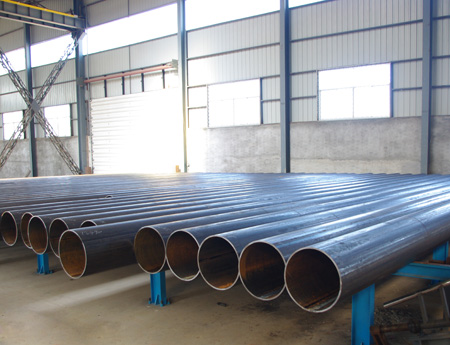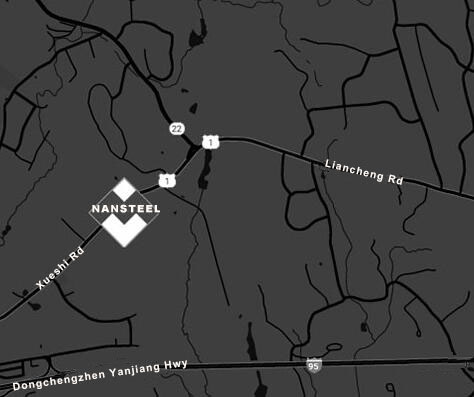Straight seam pipe is a kind of welded steel pipe, which refers to the steel pipe whose weld seam is parallel to the longitudinal direction of the steel pipe,such as LSAW pipe. The seam pipe is formed by rolling a long steel strip of a certain specification through a high-frequency welding unit and welding it with a straight seam. The specification of the straight seam pipe is represented by the nominal diameter, and can be divided into two types: thin-wall straight seam pipe and thick-wall straight seam pipe according to the wall thickness. According to the shape, it can be divided into round, square or special-shaped tubes.
Welding:
Straight seam pipes generally adopt high-frequency welding, which is a kind of induction welding (or pressure contact welding). It does not need weld filler, no welding spatter, narrow welding heat-affected zone, beautiful welding shape, good welding mechanical properties, etc., so it is widely used in the production of steel pipes. According to the principle of electromagnetic induction and the skin effect, proximity effect and eddy current heat effect of AC charges in the conductor, the steel at the edge of the weld is locally heated to a molten state. Through the extrusion of the roller, the butt weld can achieve intergranular bonding, so as to achieve the purpose of weld seam welding, and form a firm straight seam weld after cooling.

Weld gap
The strip steel is sent to the welded pipe unit, rolled by multiple rollers, and the strip steel is gradually rolled up to form a round tube blank with an opening gap. Adjust the reduction amount of the squeeze roller to control the gap between the weld seams at 1~3mm, and make the two ends of the weld joints flush. If the gap is too large, the proximity effect will be reduced, the heat of the eddy current will be insufficient, and the intergranular bonding of the weld will be poor, resulting in lack of fusion or cracking. If the gap is too small, the proximity effect will increase, the welding heat will be too large, and the weld seam will be burned; or the weld seam will form deep pits after extrusion and rolling, which will affect the surface quality of the weld seam.
Soldering temperature
Made of low carbon steel, the welding temperature is controlled at 1250~1460℃, which can meet the penetration requirements of the pipe wall thickness of 3~5mm. The welding temperature is mainly controlled by adjusting the high-frequency eddy current heat power and welding speed. When the input heat is insufficient, the heated weld edge cannot reach the welding temperature, and the metal structure remains solid, forming incomplete fusion or incomplete penetration. When the input heat is too large, the heated edge of the weld seam exceeds the welding temperature, resulting in overburning or molten droplets, so that the weld seam forms a molten hole.
Welding:
Straight seam pipes generally adopt high-frequency welding, which is a kind of induction welding (or pressure contact welding). It does not need weld filler, no welding spatter, narrow welding heat-affected zone, beautiful welding shape, good welding mechanical properties, etc., so it is widely used in the production of steel pipes. According to the principle of electromagnetic induction and the skin effect, proximity effect and eddy current heat effect of AC charges in the conductor, the steel at the edge of the weld is locally heated to a molten state. Through the extrusion of the roller, the butt weld can achieve intergranular bonding, so as to achieve the purpose of weld seam welding, and form a firm straight seam weld after cooling.

Weld gap
The strip steel is sent to the welded pipe unit, rolled by multiple rollers, and the strip steel is gradually rolled up to form a round tube blank with an opening gap. Adjust the reduction amount of the squeeze roller to control the gap between the weld seams at 1~3mm, and make the two ends of the weld joints flush. If the gap is too large, the proximity effect will be reduced, the heat of the eddy current will be insufficient, and the intergranular bonding of the weld will be poor, resulting in lack of fusion or cracking. If the gap is too small, the proximity effect will increase, the welding heat will be too large, and the weld seam will be burned; or the weld seam will form deep pits after extrusion and rolling, which will affect the surface quality of the weld seam.
Soldering temperature
Made of low carbon steel, the welding temperature is controlled at 1250~1460℃, which can meet the penetration requirements of the pipe wall thickness of 3~5mm. The welding temperature is mainly controlled by adjusting the high-frequency eddy current heat power and welding speed. When the input heat is insufficient, the heated weld edge cannot reach the welding temperature, and the metal structure remains solid, forming incomplete fusion or incomplete penetration. When the input heat is too large, the heated edge of the weld seam exceeds the welding temperature, resulting in overburning or molten droplets, so that the weld seam forms a molten hole.









